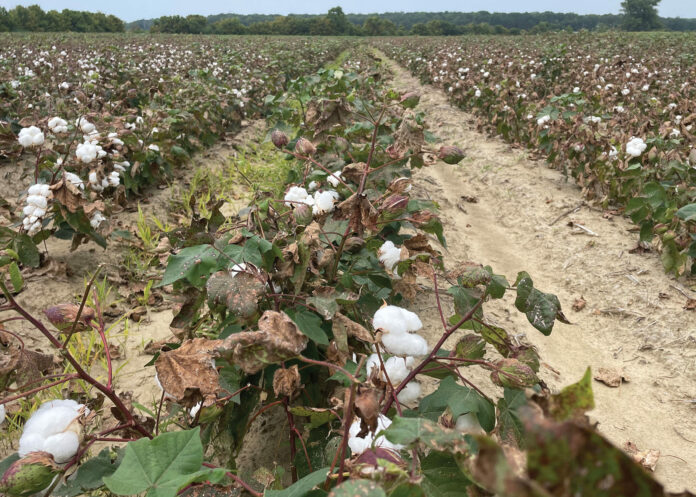Cotton Planting Dates Made A Difference This Year
Dryland cotton that was planted early experienced the most stress from the drought across most of Mississippi. This cotton was growing Aug. 14 in Oktibbeha County.BRIAN PIERALISI/MSU EXTENSION SERVICEAlt text — Dry cotton plants grow in rows in a field.###
This summer felt not only hot and dry, but close to half of Mississippi was in moderate to severe drought and temperatures were mostly in the 90s throughout August.
Mike Brown, the state climatologist and Mississippi State University professor of meteorology, said much of the northern two-thirds of the state fluctuated between drought and adequate moisture.
“Warm temperatures, lower humidity and lack of precipitation pushed us into a drought,” Brown said.
This year’s drought was made worse by the drought of 2023.
“While precipitation returned to normal in most locations toward the end of this past year and early into 2024, normal was not enough to offset deep soil moisture losses from 2023,” he said. “We needed to have several months of 110% to 125% of normal rainfall in order to recharge our deep soil moisture.”
The weather was expected to turn a bit cooler and become wetter in late September or early October.
Pastures Hit Hard
Pastures and hay fields may have struggled the most in this summer’s dry weather, and their quality has dropped. The U.S. Department of Agriculture estimated 27% of pastures were in very poor or poor condition. Of these pastures, 37% were in fair shape, 33% were good and just 3% were in excellent condition.
Hay was rated similarly as of Aug. 25. The USDA rated 24% of hay as very poor or poor, with 35% as fair, 37% as good and 4% as excellent.
Rocky Lemus, forage specialist with the MSU Extension Service, said hay production is 40% below normal since only two hay cuttings were achieved under the drought conditions.
“Some producers are tapping into their stored hay supply to maintain the livestock since available forage in the pasture is low,” Lemus said. “This will put a strain on the amount of hay that might be available this coming winter season. This means the possibility of low supply and higher prices per bale of hay.”
Cattle producers can reduce their winter hay demand by incorporating cool-season annual grazing systems. They should look now at the availability of these forages and seed prices.
How Cotton Fared
Cotton was not impacted as much by the weather because half the crop is irrigated, and cotton needs heat to properly mature. Brian Pieralisi, Extension cotton specialist, said planting date made a big difference in how cotton fared.
“Some of the earlier planted cotton really took the brunt of the drought if it wasn’t irrigated,” Pieralisi said. “Later planted cotton was in a better position for late July rains.”
Most of the state received rain the third week of July and then in early August, but before that, most of the state’s cotton growing regions had no rain all of June and half of July. The lack of rain was accompanied by high temperatures.
“Even though cotton can handle heat well, the plants need a cooler night and less humidity to reduce stress,” Pieralisi said. “That’s one of the limiting factors for pushing the envelope for higher yields.
“High humidity, especially at night, doesn’t allow the canopy to cool through respiration as well as it could with lower humidity.”
Some growers have begun defoliating cotton, with the bulk to be picked in late September to very early October. Mississippi growers planted 520,000 acres of cotton this year, up about 30% from 2023.
Will Maples, Extension agricultural economist, said even though the drought in Mississippi may impact crop yields, it will have minimal impact on market prices.
“Drought in this region usually does not move the futures market because it is a smaller production region compared to the Midwest,” Maples said.
“It definitely has some significant impacts on non-irrigated producers, but in total, they are too small to move the market.”
MSU contributed this article.
